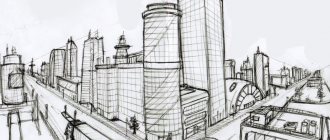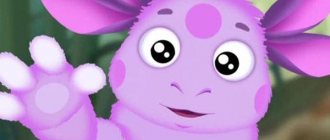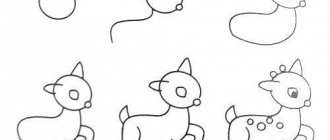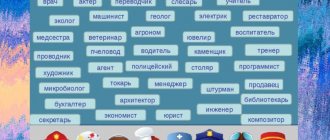On the topic: methodological developments, presentations and notes
This is an artistic activity - decorative drawing based on Dymkovo painting in the middle group.
Outline of a drawing lesson in the middle group “Dymkovo Horse”.
The summary may be of interest to teachers of preschool institutions. Contains original poems written in folk style. “Decorating a horse for a hazy carousel.
laquo;Dymkovo horse"Program objectives: Educational: to introduce children to one of the types of folk applied art - the Dymkovo clay toy; to teach children to identify elements of painting, e.
Today we again met with Dymkovo animals and consolidated our knowledge about them. We looked at different painting options, remembered how a drawing is made, what colors and colors.
Teach children to compose a composition, including familiar images, varying their size and position on the sheet. Develop smooth, easy movements when drawing a contour, visual control of movement. Zach.
Horses graze, fallow deer walk. We practice the ease of hand movement when drawing the outline of animal figures. Then we cut it out. We learn to look carefully. Conducted by teacher N. F. Khromenkova. Purpose: to teach.
Source
How to draw a horse with a pencil?
The horse is an animal that is quite heavily mythologized. This is how pegasi and unicorns appear in popular culture. They have distinctive features, but the structure and anatomy of the body is the same for all representatives of the equine species.
Children love to draw pegasi and unicorns, so today we will also look at how to realistically depict these creatures. In this way, you can accustom your child to realism, because the trend in children's drawings is now moving towards cartoonishness.
To draw a horse, you can use different construction schemes - a linear drawing or drawing through simple figures. During the construction phase, we always work with light pencil pressure.
After you learn how to correctly depict a horse, you will be able to fit it into your paintings and use painting materials.
Let's start drawing a horse in motion with a rider
Stage 1
Let's study the construction of a horse through a linear drawing. At the first stage, we outline the general shape of our image and then with light strokes we inscribe two figures - a horse and a rider. We note that the horse’s legs are not straight; the front and hind legs have different bend angles at the knees. We emphasize this detail immediately at the linear drawing stage. The horse's croup is also not straight, it has a deflection.
Stage 2
Based on our linear sketch, we begin to work out the details. We draw the horse's face; it has a fairly square shape. We draw the ears sharp and erect. We pay attention to the hooves - they also do not immediately transform from the legs - do not forget to draw a cavity on the outer and inner sides. The tail is also erect.
Stage 3
At this stage, let's focus on the rider. The seat of a person is straight, without bends, the position of an almost standing person; the weight of the person creates a deflection in the horse’s back.
Stage 4
We remove the construction lines, clarify the contours and begin to darken the shadow dreams.
Stage 5
Using a stroke, we fluff up the tail and mane, use a stroke according to the shape of the horse’s body, this will help emphasize the movement.
On the topic: methodological developments, presentations and notes
Collective work of older children. made using origami technique. Designed using waste material.
The problem of children's lack of interest in milk, lactic acid products and drinks containing milk. Children's reluctance to drink milk for the following reasons: the presence of foam, the absence of milk at home.
Help colleagues.
Today we again met with Dymkovo animals and consolidated our knowledge about them. We looked at different painting options, remembered how a drawing is made, what colors and colors.
Source
Preparing to Draw
It is always more interesting for younger children to draw and practice if an adult tells them a little about the subject they are about to study.
Here are some fun horse facts that might interest you and your child:
1. Horses can sleep either standing or lying down.
2. There are about three hundred different breeds of horses in the world.
3. The lifespan of a horse in captivity is about twenty-five years.
4. Horses have increased sensitivity.
Watercolor painting lesson “Horses in the meadow”
Olga Shapovalova
Watercolor painting lesson “Horses in the meadow”
Shapovalova Olga Vasilievna
educational area: “Artistic creativity”
drawing
Topic: “ Horses in the meadow ”
Educational objectives: learn to convey the image of a horse using watercolors ; draw characteristic features: mane, tail, hooves; learn to color an image in accordance with the color of the animal, as well as design the background of the sheet (meadow), develop creative activity, imaginative and spatial thinking.
Educational objectives: to evoke a desire to convey the expressiveness of the image in the drawing; cultivate accuracy, independence, and an emotionally positive attitude towards work.
Materials: white paper, watercolor , brushes, illustration by artist N. E. Sverchkov.
Integration of educational areas: “communication”
,
"cognition"
.
Methods and techniques: explanation, demonstration, individual assistance.
How to draw a golden-maned horse
The golden-maned horse is one of the most beloved children's heroes. Draw such a horse with your child. To make it look bright and fabulous, depict it galloping or rearing, as shown in the diagram above. For coloring, use red, burgundy, gold and orange shades! The following picture will help you get inspired for creativity.
On the topic: methodological developments, presentations and notes
This is an artistic activity - decorative drawing based on Dymkovo painting in the middle group.
Introduce students to painting folk clay toys; expand children's horizons about artistic folk crafts.
Objectives: introduce children to non-traditional drawing techniques (with palms) and finger paints; learn to draw with palms. Form friendly relationships in a team. Educate.
Today we again met with Dymkovo animals and consolidated our knowledge about them. We looked at different painting options, remembered how a drawing is made, what colors and colors.
Educator: Oinarova A.O.
Program content: continue acquaintance with Gorodets painting; consolidate children's knowledge about its characteristic features: color, elements, composition; learn to create more complex patterns.
Horses graze, fallow deer walk. We practice the ease of hand movement when drawing the outline of animal figures. Then we cut it out. We learn to look carefully. Conducted by teacher N. F. Khromenkova. Purpose: to teach.
Source
How to draw a unicorn with a pencil?
Now let's try to draw a simpler version of a unicorn horse that your children will really like. But this drawing can also be used for yourself in fantasy paintings.
Stage 1
Using simple forms we outline the figure of the animal. The complexity of this drawing lies in the rather complex spread of the unicorn. We make the front part of the body much larger than the back, using perspective.
Stage 2
Let's start working by working on the upper part, the neck should turn out to be quite massive, but do not forget about the elegant bend.
Stage 3
We continue to work on detailing, working with legs that have a rather complex shape; you should never draw the legs of an animal simply straight, this will lead to a loss of realism.
Stage 4
We finish drawing the back of the body and a very neat tail.
In order to continue drawing a horse with a pencil, we recommend working with photographs, sketching real animals and stylizing them to your taste. We will share with you some excellent references.
Did you find apk for android? You can find new Free Android Games and apps.
Method of geometric figures
Now let's look at how to draw a horse using geometric shapes, which you can slowly begin to use with children of primary school age. In the diagram below, figures in the form of ovals and circles are clearly visible.
But the technique of geometric shapes is not limited to ovals and circles. Older children also actively use triangles of different shapes, long and short lines in this technique.
How to draw a horse's head
In conclusion, I would like to talk about how to draw a horse’s head. After all, many people want to learn how to depict it close-up. A horse's head can be very beautiful, but making a quality drawing is quite difficult. The horse's head is complex in shape and requires a separate detailed study.
Children can be advised to draw their heads step by step with a pencil. It must be remembered that any complex part consists of many small particles. Therefore, together with your child, draw the head first in general terms, and then gradually detail it.
Step by step drawing of a horse's head from the side:
1. Using straight lines we outline the frontal and nasal parts of the horse’s head.
2. Add lines for the eyes and lips.
3. Draw two semicircles where the horse’s nostrils and eyes will be.
4. We detail the sketch. We highlight the eyeball, large nostril, upper and lower lip and complement the muzzle with small folds in the area of the nose, neck and eye. We also draw the ears and their inner parts, mark a small fold above the eye - the horse’s eyebrow.
5. Draw the mane and bangs.
Carefully remove all unnecessary lines with an eraser. Finally, we outline all the marked contours with clear lines.
Source






